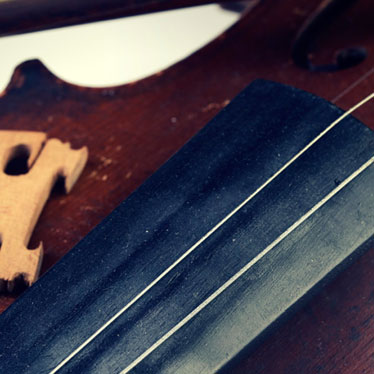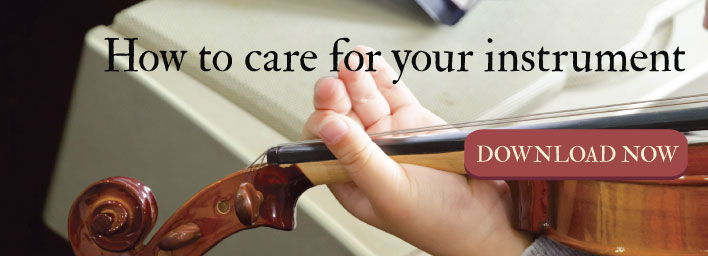Is This Violin Worth Repairing?

Maybe while helping your grandmother clean out her attic, you stumbled upon (in addition to an awesome set of antique golf clubs) what looks like a great violin. Or perhaps you’ve come across an older violin at a flea market or yard sale that the seller is willing to let go of for a song? Whatever circumstance led to your violin discovery, many people wonder if some instruments are worth the trouble and expense of repair.
The violin is a wonderful instrument that has many facets that affect its worth. Just like fine wine, great violins only get better with age; whereas an inexpensive, poorly crafted violin will only get worse. But, you can learn some basic clues about what makes a fine violin that will help your decision. And while the only real rule of thumb is to have a professional luthier (or dealer) personally inspect the violin, these tips can give you an idea on whether or not your violin is worth repairing.
Immediate Clues that Indicate Worth
Again, only a dealer, a luthier, or even a trusted violin teacher will be able to tell you if you should invest in repairing your violin. Many times, string replacements and cleaning, refitting the bridge, Soundpost, or other small fixes can make a huge difference in the look and sound of an older violin.
However, sometimes the repairs will exceed the worth of the instrument. If your violin has sentimental value and you want to play it because it belonged to your grandfather or great-grandfather then don’t hesitate. Take it to a professional luthier for complete repairs.
Alternately, if you are looking for a value priced violin to serve as your beginner instrument, repair costs may very well exceed the price of a new, quality crafted outfit from a major brand. In that case, your best option may be to chalk up that ‘flea market find’ to a lesson in experience, and move on.
These clues are easy to spot, and make it worth your while to consider a closer look:
- A Paper Label inside the Violin—this usually indicates that a craftsman created the instrument. Many fine violins were made by individuals who never received fame of fortune, and perhaps only crafted a handful of instruments in their lifetime. If you can glimpse a paper label, even one that is yellowed and curled, the violin may indeed be an exceptional instrument, worthy or repair.
- Perfling—although not always a true indictor, perfling offers an excellent clue about a violin’s worth. If you can see that the decorative inlay around the edge of the violin is actually wood, not painted, then that is a sign that the violin is worth repairing. However, don’t lean too heavily on this clue, Paolo Antonio Testore often painted his perfling, or simply omitted it.
- Scroll—if the scroll looks artistic and detailed, this is another good indicator that the violin should be taken to a dealer or luthier for appraisal. Nice violins will feature carvings that are pleasing to look at, and continue well into the center of the scroll.
Things That Don’t Matter
- Don’t worry too much about layers of crud, grime, or other gunk; it’s easy to remove.
- Missing pieces—parts of the violin can become detached with age. The glue used (hide glue) is designed to allow “crackling,” which pretty much means that it cracks easily with sufficient pressure. This is intentional, allowing a luthier to make instrument repairs. The fingerboard, bridge, chin rest, pegs and other pieces can be replaced if the violin is worth it.
- Separated seams—same as missing pieces, regluing seams is a standard repair.
Things that Can Be Fixed or Restored
If the violin is of fine quality, just about everything on the instrument can be restored. However, the restoration process is more difficult (costly) for certain repairs. Always refer to a professional for an appraisal of the instrument. And, get the opinions of your teacher, as well as a few trusted dealers because they are great resources when purchasing a violin. With a general consensus, you’ll know whether or not to proceed with a repair.
Common Repairs
- Re-gluing seams
- Peg replacement
- Small cracks (very tight and less than 2-3 inches long)
- Normal refitting tasks (Soundpost and bridge adjustments, re-string, etc.)
More Intricate (expensive) Repairs
- Large cracks
- Broken or replacement pieces
- Rib and soundpost patches, and other structural repairs
- Peg box cracks
- Neck resetting
The absolute best, most sure-fire way to know whether or not your violin is worth repairing involves a trip to a professional dealer or luthier shop. As an artisan-crafted instrument, fine violins only get better with age, and even under the most severe neglect, can be restored to beautiful functionality. If you think your violin may be worth it, it’s worth your time to take it to an expert to find out for sure.


